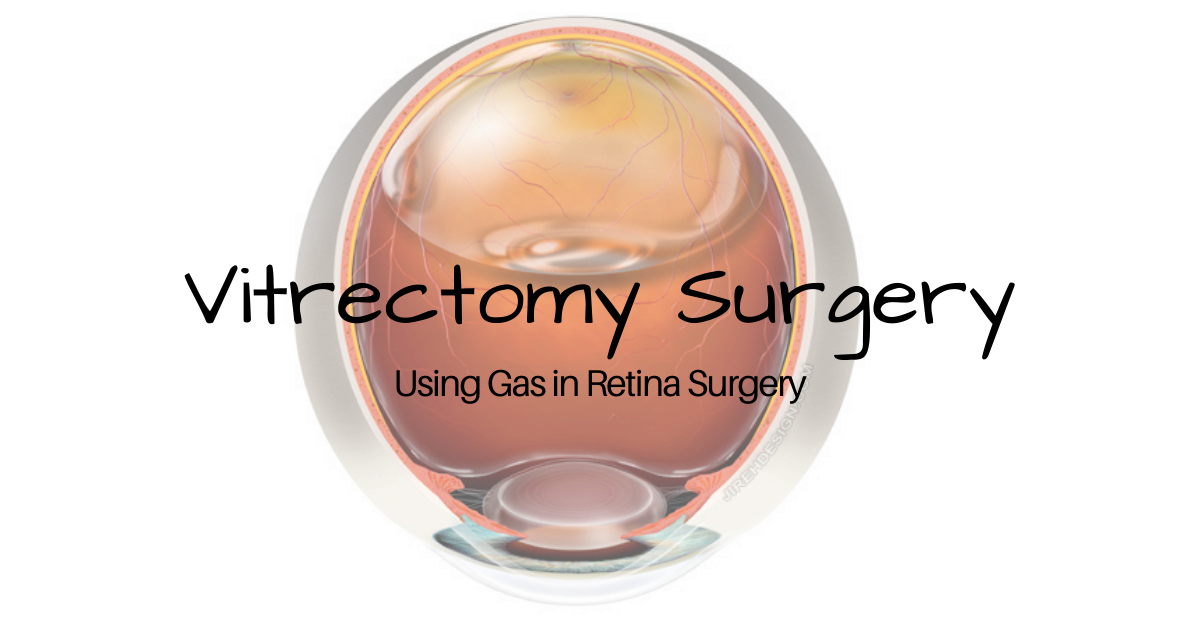Not all retina surgery requires injection of a gas bubble.
To safely work on the retina, your retina specialist must be able to safely access the inner layer of the eye. A vitrectomy, the procedure to remove the vitreous, allows the retina specialist specialist to work on the retina.
A vitrectomy (removal of the vitreous humor gel) is done for the following conditions:
- Macular hole
- Epiretinal membrane
- Vitreomacular traction
- Vitreous hemorrhage
- Tractional retinal detachment
- Rhegmatogenous retinal detachment
- Refractory macular edema
- Vitreous biopsy
- Endophthalmitis
- Dislocated intraocular lens
- Retained lens material
- Intraocular foreign bodies
The Gas Bubble
A tamponade in medical terms is something used to close or block a wound or body cavity to stop bleeding or fluid leakage.
Not all retina surgery requires gas to be injected into the eye. The most common use of gas is for repair of a retinal detachment or macular hole. In the case of the retinal detachment (specifically a rhegmatogenous retinal detachment which is caused by a retinal tear or retinal hole), the gas is used to block (tamponade) the migration of fluid to through the tear to underneath the retina.
In the case of a macular hole, the gas is used to allow the hole to slide closed by surface tension.
The gases commonly used are sulfur hexafluoride (SF6) and perfluoropropane (C3F8), and air. Each of the gases dissipates and is replaced by natural fluid, but the time for complete dissipation varies. Air dissipates and is replaced by natural fluid in 5 to 7 days. Sulfur hexafluoride (SF6) dissipates in 10 to 14 days, and perfluoropropane (C3F8), in 55 to 65 days.
The gas bubble blurs your vision while it is in place. As the bubble dissipates you will see a line across your vision where the gas meets the newly forming fluid which is gradually replacing the bubble. The line will move lower each day and your field of vision will get larger as the natural fluid continues to replace the bubble.
As long as any of the gas bubble remains in your eye you must not fly in an airplane because the bubble can expand in the reduced pressure of the cabin causing severe pain and possible loss of sight.
Head Position
Your surgeon will ask you to position yourself in a specific way during healing and that position is dependent on what part of the retina was repaired.
In cases of macular holes, a face down position is common. Head positioning for retinal detachments depends upon the location of the retinal tear(s).
Gas Bubble Injected Last
Most retina surgery is outpatient surgery and can be done under local anesthetic and mild sedation. The sedation is given by IV and is used for anxiety relief and to put you into a relaxed and sleepy state, known as a “twilight state”. In that state you are conscious and still able to hear and follow simple instructions from your surgeon.
General anesthesia can be used for patients with dementia, severe anxiety, or young children.
Most retina surgeries take less than an hour and some less than 30 minutes. The gas bubble is injected as one of the last steps of the surgery.
Recovery
You will have to wear an eye patch for a day or two following surgery. Recovery time depends on the procedure you had, but is generally two to four weeks. An exception is the repair of a complete retinal detachment which could take several months to heal and for vision to stabilize.
If you would like to schedule an appointment, please call us (877) 245.2020.
